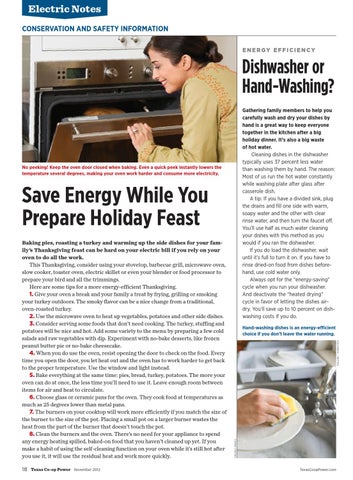Electric Notes CONSERVATION AND SAFETY INFORMATION ENERGY EFFICIENCY
Dishwasher or Hand-Washing? Gathering family members to help you carefully wash and dry your dishes by hand is a great way to keep everyone together in the kitchen after a big holiday dinner. It’s also a big waste of hot water. Cleaning dishes in the dishwasher typically uses 37 percent less water than washing them by hand. The reason: Most of us run the hot water constantly while washing plate after glass after casserole dish. A tip: If you have a divided sink, plug the drains and fill one side with warm, soapy water and the other with clear rinse water, and then turn the faucet off. You’ll use half as much water cleaning your dishes with this method as you would if you ran the dishwasher. If you do load the dishwasher, wait until it’s full to turn it on. If you have to rinse dried-on food from dishes beforehand, use cold water only. Always opt for the “energy-saving” cycle when you run your dishwasher. And deactivate the “heated drying” cycle in favor of letting the dishes airdry. You’ll save up to 10 percent on dishwashing costs if you do.
No peeking! Keep the oven door closed when baking. Even a quick peek instantly lowers the temperature several degrees, making your oven work harder and consume more electricity.
Save Energy While You Prepare Holiday Feast
18
Texas Co-op Power November 2012
P IXL AN D | T HI NKSTOCK
Hand-washing dishes is an energy-efficient choice if you don’t leave the water running.
C R E ATAS I M AG E S
Baking pies, roasting a turkey and warming up the side dishes for your family’s Thanksgiving feast can be hard on your electric bill if you rely on your oven to do all the work. This Thanksgiving, consider using your stovetop, barbecue grill, microwave oven, slow cooker, toaster oven, electric skillet or even your blender or food processor to prepare your bird and all the trimmings. Here are some tips for a more energy-efficient Thanksgiving. 1. Give your oven a break and your family a treat by frying, grilling or smoking your turkey outdoors. The smoky flavor can be a nice change from a traditional, oven-roasted turkey. 2. Use the microwave oven to heat up vegetables, potatoes and other side dishes. 3. Consider serving some foods that don’t need cooking. The turkey, stuffing and potatoes will be nice and hot. Add some variety to the menu by preparing a few cold salads and raw vegetables with dip. Experiment with no-bake desserts, like frozen peanut butter pie or no-bake cheesecake. 4. When you do use the oven, resist opening the door to check on the food. Every time you open the door, you let heat out and the oven has to work harder to get back to the proper temperature. Use the window and light instead. 5. Bake everything at the same time: pies, bread, turkey, potatoes. The more your oven can do at once, the less time you’ll need to use it. Leave enough room between items for air and heat to circulate. 6. Choose glass or ceramic pans for the oven. They cook food at temperatures as much as 25 degrees lower than metal pans. 7. The burners on your cooktop will work more efficiently if you match the size of the burner to the size of the pot. Placing a small pot on a larger burner wastes the heat from the part of the burner that doesn’t touch the pot. 8. Clean the burners and the oven. There’s no need for your appliance to spend any energy heating spilled, baked-on food that you haven’t cleaned up yet. If you make a habit of using the self-cleaning function on your oven while it’s still hot after you use it, it will use the residual heat and work more quickly.
TexasCoopPower.com
